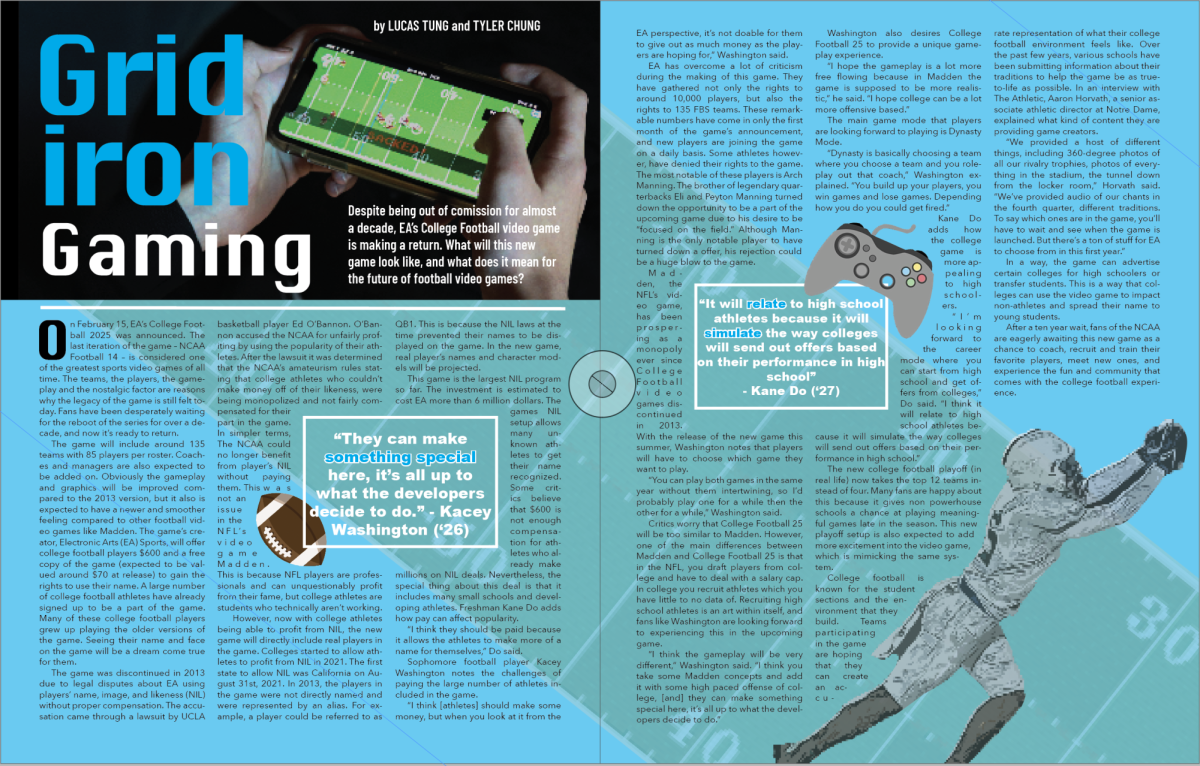On February 15, EA’s College Football 2025 was announced. The last iteration of the game – NCAA Football 14 – is considered one of the greatest sports video games of all time. The teams, the players, the gameplay and the nostalgic factor are reasons why the legacy of the game is still felt today. Fans have been desperately waiting for the reboot of the series for over a decade, and now it’s ready to return.
The game will include around 135 teams with 85 players per roster. Coaches and managers are also expected to be added on. Obviously the gameplay and graphics will be improved compared to the 2013 version, but it also is expected to have a newer and smoother feeling compared to other football video games like Madden. The game’s creator, Electronic Arts (EA) Sports, will offer college football players $600 and a free copy of the game (expected to be valued around $70 at release) to gain the rights to use their name. A large number of college football athletes have already signed up to be a part of the game. Many of these college football players grew up playing the older versions of the game. Seeing their name and face on the game will be a dream come true for them.
The game was discontinued in 2013 due to legal disputes about EA using players’ name, image, and likeness (NIL) without proper compensation. The accusation came through a lawsuit by UCLA basketball player Ed O’Bannon. O’Bannon accused the NCAA for unfairly profiting by using the popularity of their athletes. After the lawsuit it was determined that the NCAA’s amateurism rules stating that college athletes who couldn’t make money off of their likeness, were being monopolized and not fairly compensated for their part in the game. In simpler terms, The NCAA could no longer benefit from player’s NIL without paying them. This was not an issue in the NFL’s video game Madden. This is because NFL players are professionals and can unquestionably profit from their fame, but college athletes are students who technically aren’t working.
However, now with college athletes being able to profit from NIL, the new game will directly include real players in the game. Colleges started to allow athletes to profit from NIL in 2021. The first state to allow NIL was California on August 31st, 2021. In 2013, the players in the game were not directly named and were represented by an alias. For example, a player could be referred to as QB1. This is because the NIL laws at the time prevented their names to be displayed on the game. In the new game, real player’s names and character models will be projected.
This game is the largest NIL program so far. The investment is estimated to cost EA more than 6 million dollars. The games NIL setup allows many unknown athletes to get their name recognized. Some critics believe that $600 is not enough compensation for athletes who already make millions on NIL deals. Nevertheless, the special thing about this deal is that it includes many small schools and developing athletes. Freshman Kane Do adds how pay can affect popularity.
“I think they should be paid because it allows the athletes to make more of a name for themselves,” Do said.
Sophomore football player Kacey Washington notes the challenges of paying the large number of athletes included in the game.
“I think [athletes] should make some money, but when you look at it from the EA perspective, it’s not doable for them to give out as much money as the players are hoping for,” Washington said.
EA has overcome a lot of criticism during the making of this game. They have gathered not only the rights to around 10,000 players, but also the rights to 135 FBS teams. These remarkable numbers have come in only the first month of the game’s announcement, and new players are joining the game on a daily basis. Some athletes however, have denied their rights to the game. The most notable of these players is Arch Manning. The brother of legendary quarterbacks Eli and Peyton Manning turned down the opportunity to be a part of the upcoming game due to his desire to be “focused on the field.” Although Manning is the only notable player to have turned down a offer, his rejection could be a huge blow to the game.
Madden, the NFL’s video game, has been prospering as a monopoly ever since College Football video games discontinued in 2013. With the release of the new game this summer, Washington notes that players will have to choose which game they want to play.
“You can play both games in the same year without them intertwining, so I’d probably play one for a while then the other for a while,” Washington said.
Critics worry that College Football 25 will be too similar to Madden. However, one of the main differences between Madden and College Football 25 is that in the NFL, you draft players from college and have to deal with a salary cap. In college you recruit athletes which you have little to no data of. Recruiting high school athletes is an art within itself, and fans like Washington are looking forward to experiencing this in the upcoming game.
“I think the gameplay will be very different,” Washington said. “I think you take some Madden concepts and add it with some high paced offense of college, [and] they can make something special here, it’s all up to what the developers decide to do.”
Washington also desires College Football 25 to provide a unique gameplay experience.
“I hope the gameplay is a lot more free flowing because in Madden the game is supposed to be more realistic,” he said. “I hope college can be a lot more offensive based.”
The main game mode that players are looking forward to playing is Dynasty Mode.
“Dynasty is basically choosing a team where you choose a team and you role-play out that coach,” Washington explained. “You build up your players, you win games and lose games. Depending how you do you could get fired.”
Kane Do adds how the college game is more appealing to high schoolers.
“I’m looking forward to the career mode where you can start from high school and get offers from colleges,” Do said. “I think it will relate to high school athletes because it will simulate the way colleges will send out offers based on their performance in high school.”
The new college football playoff (in real life) now takes the top 12 teams instead of four. Many fans are happy about this because it gives non powerhouse schools a chance at playing meaningful games late in the season. This new playoff setup is also expected to add more excitement into the video game, which is mimicking the same system.
College football is known for the student sections and the environment that they build. Teams participating in the game are hoping that they can create an accurate representation of what their college football environment feels like. Over the past few years, various schools have been submitting information about their traditions to help the game be as true-to-life as possible. In an interview with The Athletic, Aaron Horvath, a senior associate athletic director at Notre Dame, explained what kind of content they are providing game creators.
“We provided a host of different things, including 360-degree photos of all our rivalry trophies, photos of everything in the stadium, the tunnel down from the locker room,” Horvath said. “We’ve provided audio of our chants in the fourth quarter, different traditions. To say which ones are in the game, you’ll have to wait and see when the game is launched. But there’s a ton of stuff for EA to choose from in this first year.”
In a way, the game can advertise certain colleges for high schoolers or transfer students. This is a way that colleges can use the video game to impact non-athletes and spread their name to young students.
After a ten year wait, fans of the NCAA are eagerly awaiting this new game as a chance to coach, recruit and train their favorite players, meet new ones, and experience the fun and community that comes with the college football experience.
CLICK THE LINK HERE TO SEE SOME STATS SINCE THE LAST ITERATION OF A COLLEGE FOOTBALL VIDEO GAME: Stats Since The Last College Football Video Game




